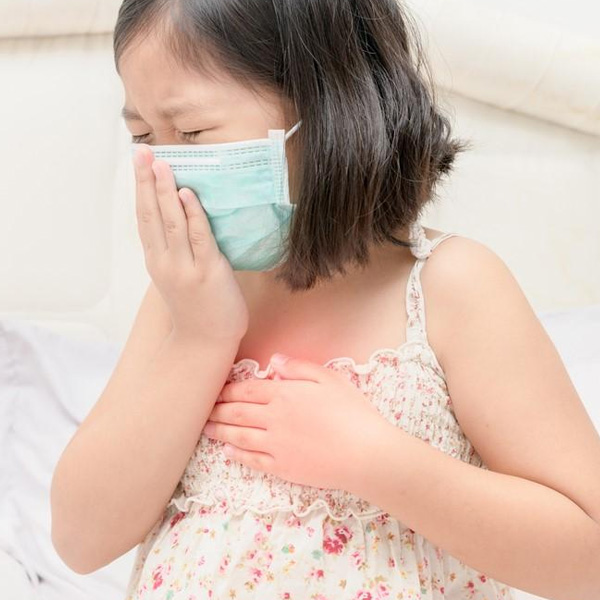Common Paediatric Conditions
Our foremost objective is to ensure that your child enjoys the highest standard of health and well-being. Our dedicated team is committed to providing unwavering support throughout every stage of your child’s development and growth. We offer specialized care for a wide range of common childhood conditions, including acute infections, asthma, atopic dermatitis (eczema), allergies, and abdominal pain, among others, ensuring that each child’s unique needs are thoroughly addressed and managed with expertise and compassion.
(1) Acute Infections
Children often experience illnesses from time to time, primarily due to their increased exposure to a wide array of germs, especially in environments like child care centers and schools where they interact closely with peers. As their bodies encounter and combat these infections, they gradually build a robust immunity that helps protect them in the future. Dr. Yeo is skilled in the diagnosis and treatment of various pediatric infections, offering expert care for conditions such as the common cold, upper respiratory tract infections, sore throats, chest infections, as well as digestive issues like diarrhea and vomiting, and skin concerns such as rashes. His comprehensive approach ensures that our young patients receive the attentive care they need to recover and thrive.
(2) Common Cold
Don’t let colds dampen your child’s spirits! Viral infections of the upper respiratory tract can often be managed with a few gentle remedies. Consider using soothing nasal saline drops to relieve congestion and warm baths to provide comfort and relaxation. Nevertheless, if your child shows signs of shortness of breath, experiences a high or persistent fever, feels unusually tired or lethargic, or complains of an intensifying headache, it’s essential to seek medical advice without delay to ensure their well-being.
(3) Sore Throat
Pharyngitis, or a sore throat, is quite common in children and can be linked to either viral or bacterial infections. While antibiotics aren’t needed for viral cases, bacterial pharyngitis can be effectively treated with the right medication.
(4) Diarrhoea & Vomiting
Diarrhoea and vomiting are distressing symptoms that can affect individuals of all ages, from adults to infants. They are often triggered by a stomach virus, commonly referred to as a stomach bug, and in many cases, these symptoms subside naturally within a few days. The paramount concern during this time is to maintain hydration, as fluid replenishment is vital to prevent the serious complication of dehydration.
Vomiting often serves as an early warning sign of gastroenteritis, particularly in children. Fortunately, most young ones who experience these symptoms can be effectively managed at home. Oral rehydration solutions (ORS) are highly recommended for this purpose. Alternatively, you can dilute fresh apple juice to half strength, which can also help soothe upset stomachs. The strategy here is to administer very small amounts frequently—such as giving 5 milliliters every five minutes—to aid in hydration without triggering further vomiting.
As the condition improves and vomiting becomes less frequent, you can gradually increase both the quantity and the intervals of ORS, apple juice or rice water provided. It’s important to note that medications aimed at alleviating vomiting or diarrhoea are generally unnecessary and may not be beneficial.
Should you become concerned that your child may be displaying signs of dehydration, it’s crucial to be vigilant for specific symptoms, including:
- A dry, parched mouth
- Sunken appearance of the eyes
- Intense thirst that seems unquenchable
- A notable lack of urination over the past 8-12 hours or urine that appears dark and concentrated
- Unusual lethargy or fatigue
- Absence of tears when crying, which can be particularly alarming.
Recognizing the seriousness of dehydration is vital, especially in young children. If your child is under six months old, is persistently vomiting (especially if the vomit has a green or brown hue), has visible blood in their stools, or has been suffering from diarrhoea for more than 24 hours, it is imperative to seek medical assistance immediately. Prompt action can make all the difference in ensuring a swift recovery.
(5) Urinary Tract Infections
Urinary Tract Infections (UTIs) are a prevalent health issue among children, especially in girls. Common symptoms associated with UTIs include pain and a burning sensation during urination, as well as urine that may appear smelly, cloudy, or bloody. Other signs to look for include frequent urination, abdominal or back pain, poor feeding habits, and fever in younger children. The encouraging news is that UTIs are generally easy to treat with antibiotics. However, proper diagnosis and timely treatment are essential to prevent potential long-term complications.
(6) Bronchiolitis
Bronchiolitis is a prevalent viral respiratory infection that primarily impacts infants and young children under the age of 2. This condition typically manifests with mild symptoms, including rapid or wheezy breathing and challenges with feeding during these vulnerable early years.
Respiratory Syncytial Virus (RSV) is a highly contagious virus that can lead to bronchiolitis. Starting in 2025 in Singapore, parents will have access to a groundbreaking long-lasting injection designed to protect against this widespread virus. Unlike traditional vaccines, which encourage the body to generate its own immune response, the RSV monoclonal antibody injection (e.g. Nirsevimab) provides ready-made immune defense directly to infants. This innovative treatment establishes a strong barrier that significantly reduces the risk of RSV infecting vulnerable cells, giving families peace of mind during the two RSV seasons: June to August and November to January.
Nevertheless, it is crucial to seek medical attention if your child exhibits any of the following concerning signs:
- Difficulty in breathing, which may include grunting sounds or a noticeable pulling in of the tummy beneath the ribs.
- Inadequate feeding, leading to concerns about their nutritional intake.
- Indicators of dehydration, such as a noticeable decrease in the number of wet nappies compared to usual.
- A fever in a baby younger than 3 months old, particularly if it exceeds 38 degrees Celsius.
- A fever in a baby older than 3 months that rises above 39 degrees Celsius.
- Extreme fatigue or increased irritability, which may signal a more serious issue.
Prompt attention to these symptoms can help ensure the well-being of your child.
(7) Hand Foot and Mouth Disease
Hand, Foot, and Mouth Disease (HFMD) is a contagious viral infection primarily caused by the Coxsackie virus. This illness often manifests in young children, leading to uncomfortable sores around the mouth and throat, as well as a characteristic rash on the hands, feet, and occasionally the diaper area. The onset typically features a high fever that can persist for several days, leaving little ones feeling irritable and in pain, especially when trying to eat or drink.
HFMD can produce a range of symptoms, including:
- Fever: A sudden rise in body temperature, often accompanied by chills and discomfort.
- Sore Throat: A painful sensation that can make swallowing very challenging and unpleasant.
- Blister-like Lesions: Painful sores that may appear on the tongue, gums, and inner cheeks, resembling tiny blisters that can be quite sensitive.
- Rash: A non-itchy rash typically emerges on the palms of the hands, soles of the feet, and sometimes the buttocks. This rash can appear red, white, or grey, and may consist of small bumps or blisters that can vary depending on the child’s skin tone.
- Loss of Appetite: Due to discomfort and pain in the mouth, children may refuse food and drinks.
- Peeling Skin: In some cases, peeling of the fingers or toes, or even the loss of nails, can occur weeks to months after the initial infection, serving as a lingering reminder of the illness.
While there is no specific cure for HFMD, medical care can provide relief from symptoms. It is crucial for parents to ensure that their children stay well-hydrated to avoid dehydration, which is a common complication of this illness. Offering soothing options such as cold dairy products can help ease sore throats and are typically enjoyed by children.
Additionally, saltwater mouth rinses—prepared by mixing 1/2 teaspoon of salt in a glass of warm water—can offer further comfort for the irritated mouth and throat.
During the first week of HFMD, children are most contagious, making it essential to limit their contact with others to prevent spreading the virus. It is recommended to keep them away from childcare or school until their fever has resolved and mouth sores have healed completely. Similarly, if you are feeling unwell, it’s wise to remain at home from work to protect others from potential infection.
Generally, HFMD is a mild viral infection that leads to fever and mild symptoms for a brief period. However, the most common complication associated with the disease is dehydration, which can develop into a serious issue. If your child is younger than six months, has a weakened immune system, or experiences severe mouth sores or a sore throat that prevents them from drinking comfortably, it’s important to seek medical advice promptly. Additionally, if your child’s symptoms show no improvement after 10 days, consulting a healthcare professional is strongly advised
(8) Asthma & Wheezes
Asthma is one of the most prevalent childhood illnesses, impacting nearly 20% of children in Singapore? For parents, hearing that their child has been diagnosed with asthma can evoke feelings of concern and anxiety. The good news is that, even with this condition, your child can still thrive and enjoy an active, fulfilling life.
Asthma is a chronic respiratory condition characterized by the inflammation and hypersensitivity of the airways. This means that the air passages are not only swollen but also more reactive than ordinary airways. When a child encounters specific triggers—such as allergens or irritants—these inflamed airways release inflammatory chemicals, causing them to constrict. This leads to episodes of wheezing and difficulty breathing.
Children with asthma often exhibit a range of symptoms, including persistent chest tightness, shortness of breath, cough, and wheezing. Chest tightness may particularly affect older children and is often noticeable after vigorous physical activities. Shortness of breath can become so pronounced that it interrupts everyday activities, restful sleep, or even playtime. The nature of the cough can vary significantly; some children experience a dry, hacking cough, while others may have a moist cough, accompanied by phlegm that is whitish or yellowish in color. Wheezing, which produces a distinct whistling sound during exhalation, may not be present in all cases but is often a telltale sign of an asthma flare-up.
Asthma attacks can be triggered by an array of factors, including environmental allergens, irritants, sudden changes in weather, and viral infections. Frequent culprits are indoor allergens like dust mites, pet dander, mold, and various types of pollen. While food allergies are considered less common, certain foods—such as peanuts, eggs, and dairy—can provoke severe asthma symptoms in some children. Moreover, exposure to air pollution and cigarette smoke poses serious risks for those with asthma. Sudden shifts in weather, especially cold and dry air, can also spark an asthma episode. Young children may experience a resurgence of symptoms for up to two weeks following a viral respiratory infection.
It’s vital to understand that every child’s experience with asthma is unique. To provide the best possible care for your little one, consulting with a pediatrician to develop a personalized management plan is essential.
(9) Abdominal pain & Constipation
As a parent, it’s completely natural to feel a wave of concern when your child complains of a tummy ache. However, it’s important to understand that abdominal discomfort is a common issue among children, often resolving on its own without the need for medical intervention.
In many cases, the source of discomfort can be attributed to manageable conditions such as constipation, urinary tract infections, or gastroenteritis. These issues are typically straightforward to treat and can often be alleviated with proper care. While less frequent, appendicitis is another potential cause for tummy aches that warrants attention.
It’s worth noting that in numerous instances of chronic abdominal pain in children, no specific underlying cause is identified, and the discomfort dissipates naturally over time. Generally speaking, the majority of tummy aches in children are not serious and can be effectively managed with basic remedies such as ensuring adequate rest, maintaining hydration with plenty of fluids, and encouraging a balanced, healthy diet. Keeping these simple approaches in mind can help ease both the discomfort experienced by your child and the worry felt by you as a parent.
(10) Infantile Colic
Infantile colic is a condition that affects seemingly healthy infants under the age of four months, resulting in episodes of persistent, intense crying that can last for several hours. This distressing behavior typically arises without any identifiable medical issues. Colic is characterized by crying spells that occur at a consistent time each day, often in the late afternoon or early evening, creating a sense of routine that can be puzzling for parents. During these episodes, the infant may exhibit signs of discomfort, such as flailing their arms and legs, clenching their tiny fists, and drawing their legs up toward their belly. They may also pass gas, which can add to the perception of unease, yet during non-crying periods, the infant appears to be perfectly healthy and content.
The precise cause of colic remains elusive, though several theories exist. For formula-fed infants, sensitivities or allergies to specific proteins in the formula may contribute to their distress. Another possibility is lactose malabsorption, where the infant struggles to digest certain sugars, resulting in discomfort and poor nutrient absorption from their milk. Additionally, the sensory overwhelm from bright lights and loud noises, particularly during the evening hours, may lead to overstimulation. In this state, infants can become overstressed, causing them to cry inconsolably and making it challenging for caregivers to soothe them.
If you suspect your infant is suffering from colic, it’s wise to consult a pediatrician. Your doctor will eliminate other potential causes for the distress, such as gastrointestinal issues or urinary infections, and monitor your child’s feeding and growth patterns. With a thorough evaluation, your doctor can guide you on appropriate next steps, providing you with strategies to manage your child’s colic and offer much-needed support during this challenging time.
(11) Constipation
Constipation is a prevalent concern that affects infants and children, characterized by infrequent or difficult bowel movements. Understanding this condition is vital, as its origins are multifactorial and seldom linked to structural, endocrine, or metabolic diseases.
One of the most frequent triggers of constipation in children is the discomfort associated with painful bowel movements. This discomfort can arise from various factors, including the challenges of toilet training, abrupt changes in daily routines or dietary habits, stressful life events, acute illnesses, or the habit of delaying defecation. The condition often emerges during three key developmental stages: during the weaning process in infancy, as toddlers learn to use the toilet, and when children reach school age. It’s important to recognize that straining in infants under one year does not necessarily indicate constipation; these little ones are still honing their muscle control for effective bowel movements. As long as they pass soft stools and maintain overall health, this straining can be considered a normal part of their development.
The diagnosis of constipation typically involves a comprehensive history-taking and a thorough physical examination. In certain instances, healthcare providers may recommend blood tests or imaging studies to rule out any underlying treatable causes. In rare situations, a rectal biopsy—a procedure to obtain a tissue sample from the rectum—may be warranted to diagnose Hirschsprung’s disease, a rare and serious condition that disrupts the normal functioning of the bowel’s nerves.
Fortunately, most cases of constipation can be effectively managed through dietary interventions that emphasize a rich intake of fluids and fiber. In some cases, healthcare professionals may prescribe laxatives to alleviate the symptoms and restore regular bowel function.
If you have any further questions, you can schedule an appointment today with Dr Yeo.






